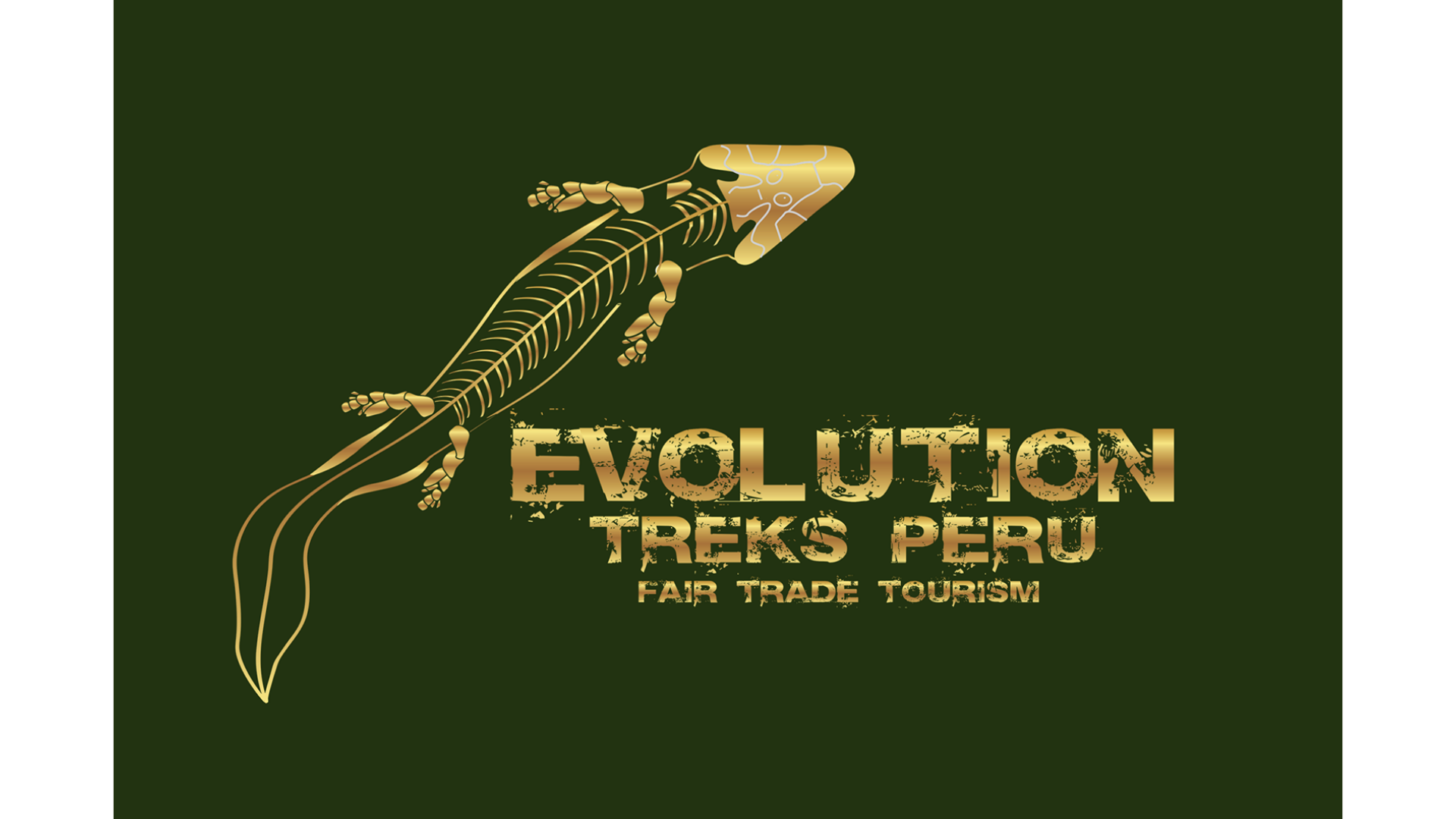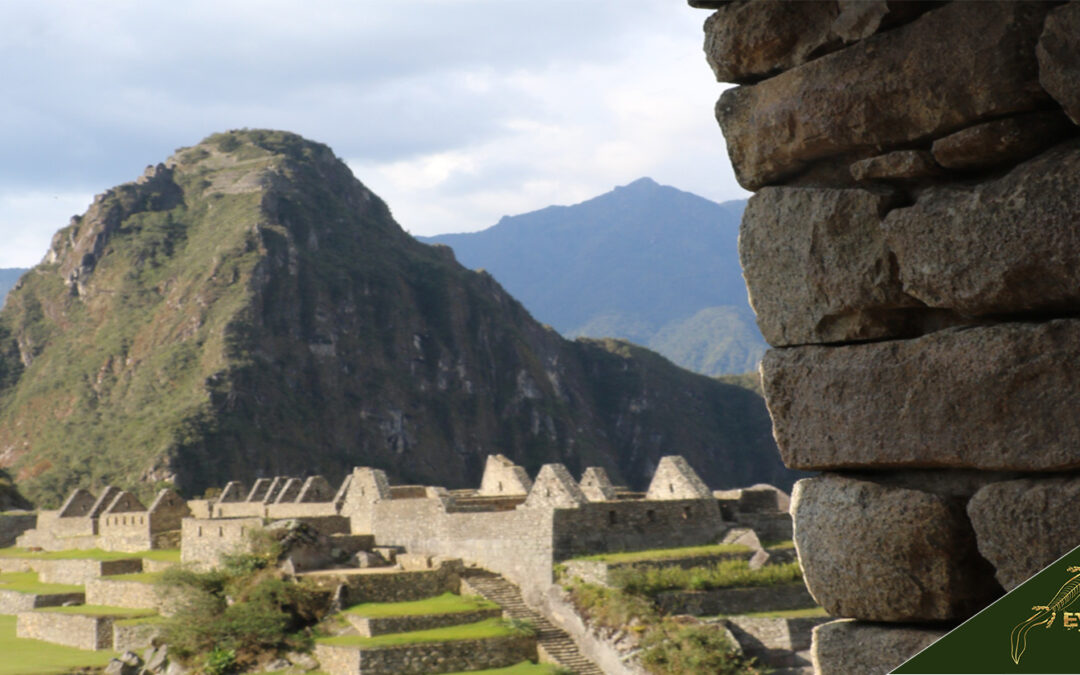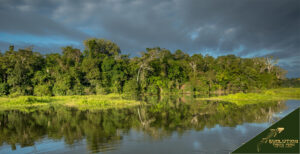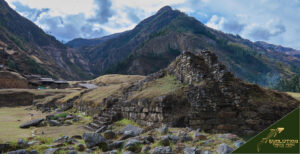Huayna Picchu, or Wayna Picchu, is a mountain in the Machu Picchu National sanctuary of Peru. It belongs to the eastern foothills of the Salcantay massif in Cuzco. It is part of a sizeable orographic formation known as the Vilcabamba Batolith in the Central Cordillera of the Andes. The Mountain has a steep ridge around which the Urubamba River curves. It originated from a series of earthquakes in a series of faults located where it sits.
Huayna Picchu houses essential archaeological remains related to the famous Inca complex of Machu Picchu. Huayna means young, and Picchu means Mountain. Huayna Picchu is called “Young Mountain” or “New Mountain” in the Quechua language. Huayna Picchu was a place of worship, as evidenced by the Temple of the Moon, which served as a surveillance center of the citadel of Machu Picchu. It was abandoned approximately at the end of the sixteenth century and, thanks to the studies of Hiram Bingham in the early twentieth century, began to attract the world’s attention.
There are temples, terraces, and fantastic landscapes that can be seen throughout the Mountain. Its summit is an alternative way to contemplate the Andes mountain range, including the peak of Machu Picchu. The place offers a panoramic view of the Vilcanota River and Aguas Calientes.
Most historians consider that Pachacutec Inca Yupanqui built the site of Huayna Picchu in the middle of the 15th century. Huayna Picchu mountain offers steeper trails compared to Machu Picchu. The best-known part of those trails is called the “stairs of death,” where special care should be taken. The climate of the Huayna Picchu mountain ranges between 19° C and 21 °C as maximum and minimum from 8 °C to 11 °C. The highest altitudes in the area drop to 0 °C at night. Huayna Picchu, concerning Machu Picchu, is important for Peru’s history, traditions, and customs. The remarkable constructions and architectural forms found on the Mountain are valuable evidence of the skills and productivity of the Incas as a community.
According to projections by the Peruvian Ministry of Culture, in 2022, approximately 120,000 people climbed Huayna Picchu. Every day only a maximum of 400 visitors are accepted, and the longest time a person can stay within the mountain premises is four hours.
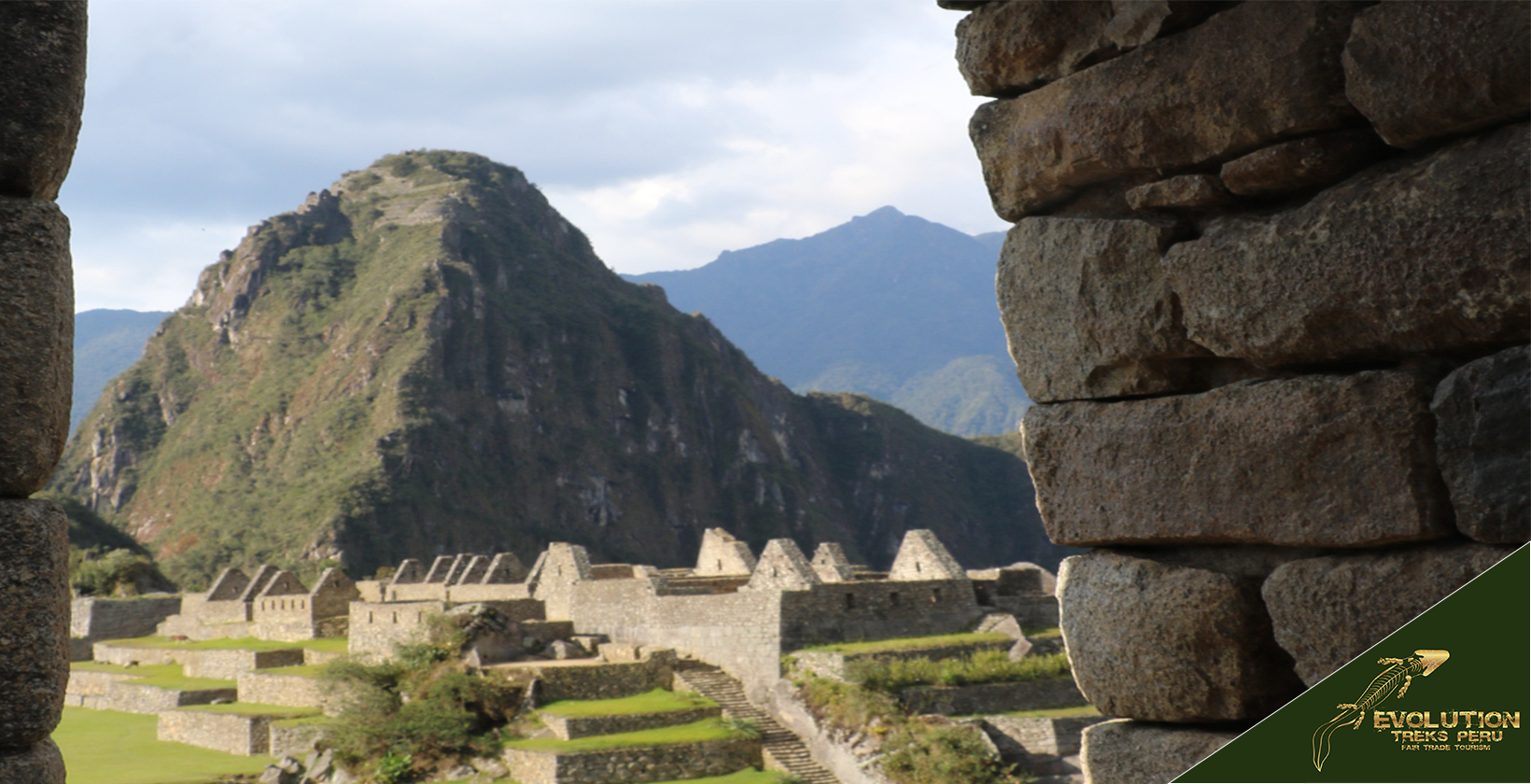
What is the Huayna Picchu History?
The history of Huayna Picchu is closely linked to the history of Machu Picchu. It is believed that the original inhabitants of those territories worshiped this summit before the arrival of the Incas. Scholars believe that it was the Inca Pachacutec who, approximately in the year 1450 AD, ordered the site’s construction.
Huayna Picchu would have served as the Inca citadel’s lookout and control post. In addition, due to its high altitude, religious ceremonies were held there in honor of the gods. As proof of this, we can admire the Temple of the Moon. From the evidence found, it is believed that these temples were still being built until the sacred Inca city had to be abandoned; with the arrival of the Spaniards to Cusco in 1535, most of its constructions were covered by thick vegetation. Even today, it isn’t easy to access there.
In 1911, with the arrival of the American explorer Hiram Bingham, Machu Picchu and Huayna Picchu, the Young Mountain, were made known to the world. Excavations and research began at the site.
Recent archeological and historical studies by researchers of the Ministry of Culture of Peru and the University of Illinois suggest that the Inca people called the citadel of Machu Picchu; Huayna Picchu. In their conclusions, they state that the current name was generalized from the publications of Hiram Bingham.
Indeed, in their works published in the magazine Ñawpa Pacha: Journal of Andean Archaeology, carried out by the historian Donato Amado González, of the Ministry of Culture of Peru, and the archaeologist Biran S. Bauer, of the University of Illinois, the primary denomination is put in doubt. According to them, Machu Picchu was called Huayna Picchu during the Incas’ time.
The study’s authors examined in depth the diaries of the American explorer but also analyzed documents from the seventeenth century and toponymic data on maps from the nineteenth century. Amado and Bauer conclude that the name Machu Picchu to designate this Inca citadel became generalized after 1911, with Bingham’s publications.
Among the various researchers and scientists who have worked and contributed to the knowledge about Huayna Picchu and Machu Picchu Picchu, we can name Johan Reinhard, John Rowe, John Hemming, and Federico Kauffmann Doig.
What are the theories about Huayna Picchu?
Below is a list of the most scientifically backed theories about the origin of Huayna Picchu and Macchu Picchu.
- It may have been the end of a pilgrimage.
A new theory, proposed by Italian archaeologist Giulio Magli, suggests that the journey to Machu Picchu from Cuzco may have had a ceremonial purpose: to relive the celestial journey that, according to legend, the first Inca made when he left the Island of the Sun in Lake Titicaca. Instead of following the more sensible path along the banks of the Urubamba River, the Inca built the impractical but visually impressive Inca Trail that was prepared for pilgrims to enter Machu Picchu. - It could have been the center of origin of the Incan elite.
Hiram Bingham considered that Machu Picchu was the mythical Tampu Tocco. The place from where, according to legend, the first Inca ruler, Manco Capac, departed. Today it is known that Machu Picchu is neither Vilcabamba nor Tampu Tocco, although there has yet to be a final agreement on what it was. - It was the center of the connection between the impressive natural surroundings and astronomical phenomena. In 1991, the American archaeologist Johan Reinhard argued in his book The Sacred Center that the impressive location of the llaqta of Machu Picchu was related to the nearby mountains, apus, which were the pinnacle of the Inca cult of the natural world, as well as being the source of water and associated with astronomical phenomena.
- It was a royal state that belonged to the Inca king Pachacuti. A turning point in Macchu Picchu studies came in 1986 when Berkeley professor John Rowe analyzed a 1568 document in which informants, including the caciques of Tambo and Picchu, indicated that Pachacútec conquered the area and that most of the land in the lower part of the valley belonged to him. Rowe proposed that the Machupicchu citadel was a property based on this and other considerations. Also, Craig Morris and Adriana von Hagen consider Machupicchu as the culmination of a series of monuments along the Yucay valley and the Inca Trail so that it could have been a religious destination or, due to its modest defenses, founded as a frontier post, which evolved into the main of Pachacutec’s royal estates. Some researchers such as Brian Bauer, Terence D’Altroy, Susan Niles, Jean-Pierre Protzen, and John Hemming agree in considering the llaqta of Machu Picchu as a royal palace of Pachacutec, one of the four he built in the Yucay valley north of Cusco.
- It was part of an extensive system of agricultural development. The distinguished archaeologist Federico Kauffmann Doig does not accept that Pachacútec needed a site of such magnitude to get by, considering that Machu Picchu and the nearby monuments were part of a large agricultural project. Archaeologists such as Fernando Astete, Alfredo Mormontoy, and José Bastante, who have excavated and surveyed both the llaqta and numerous monuments in the Historic Sanctuary, agree to some extent with Kauffmann, but consider that Machu Picchu was built – taking into consideration the sacred geography of the site – as a political-administrative and religious center that served as the most critical site in the area and as a nexus between the Andes and the Amazon.
What are the myths about Huayna Picchu?
The following are some of the best-known myths about Huayna and Machu Picchu.
Myth #1: Huayna Picchu and Machu Picchu were built by enslaved people.
Myth #2: The Huayna Picchu mountain is much higher than it is.
Myth #3: Cable cars can climb to Huayna Picchu’s top.
Myth #4: Guided tours are necessary to climb Huayna Pichu.
Myth #5: Travelers staying at the Belmond Sanctuary Lodge can get exclusive off-operation hours to climb Huayna Picchu.
Myth #6: Machu Picchu was the first city the Inca built and was entirely covered in gold.
Myth #7: The rocks are Machu Picchu were cut with laser beams
Myth #8: Huayna Pichu and Machu Picchu were built by aliens
How was Huayna Picchu formed?
Both Huayna Picchu and Machu Picchu were purposely built on tectonic faults by the Inca civilization.
According to recent studies, this underlying network of faults and fractures served as a base for quarrying, facilitated water supply, and protected the site from avalanches and landslides.
Machu Picchu lies just above the mutual intersection of three main fault directions and two secondary directions running north-south and east-west, almost forming an “X.”
It was also discovered that the main sectors, buildings, and stairways at Machu Picchu appear to be oriented along the directions of these faults.
According to such analyses, the Incas, who were master stone workers, deliberately chose sites like this one at the intersection of faults, partly because they offered abundant building materials in the form of pre-fractured rocks.
In addition to helping shape the individual stones, the network of faults at Machu Picchu probably offered the Incas other advantages, such as an easily accessible water source.
According to Brazilian scientist Rualdo Menegat, tectonic faults in the area channeled meltwater and rainwater directly to the site.
Additionally, his research suggests that building the shrine in such a high location helped drain the site during the intense storms prevalent in the region, “about two-thirds of the effort to build the shrine involved the construction of subway drains,” states Menegat, quoted in National Geographic.
Is Huayna Picchu Important for Peru’s History?
Huayna Picchu is significant to the history of Peru as it symbolizes the strength and resilience of the Inca people to conquer the most inhospitable terrains and sharp mountains. Huayna Picchu stands as the guardian of the citadel of Machu Picchu and the might of the Incan people.
Huayna Picchu has been important to the history of Peru since the Inca civilization was discovered. The Inca civilization was prominent in Peru between c. 1400 and 1533 CE. The people of the Inca were South American Indians. Its civilization reached up to the west of South America. Its scope covered parts that started from Quito to Santiago.
During their years of civilization, their empire was the largest in America and the world as well. The Incas conquered communities and land of various forms. The Incas were able to discover different settings, including plains, mountains, jungles, and deserts. Its civilization flourished with its unique art and architecture.
The people of the Inca created pristine architectural sites and buildings, which have been appreciated up until now. Inca civilization ended due to the Spanish colonization in 1572. The three unique aspects of Huayna Picchu are its pre-Columbian architecture, steep stairway, and its high peak. The pre-Columbian architecture in Huayna Picchu is majestic and was built by the Inca Empire.
The architecture is part of the country’s protected and preserved sites. There is only one trail leading to the mountain of Huayna Picchu, which has a steep stairway. The stairway is narrow and slippery, which is dangerous for all hikers. The mountain of Huayna Picchu is 2,720 meters, while Machu Picchu is 3,051. The mountain of Huayna Picchu is steeper than Machu Picchu.
Is Huayna Picchu safe?
Huayna Picchu is only safe for some. The route is one of the most complicated in Machu Picchu. It requires good physical endurance, demand, and momentum to get to the top because the journey will take about an hour. The path is steep and narrow, and the stairs are made of granite stones placed unevenly, so you must be very careful when stepping on them. There are better hikes for people with a fear of heights or cardiac problems.
Where is Huayna Picchu located?
Huayna Picchu is located in the Machu Picchu district of the province of Urubamba in the southern Andes of Peru. It stands at 2,667 meters above sea level in the Cusco region of Peru and rises behind the so-called lost city of the Incas, Machu Picchu.
What are the coordinates of Huayna Picchu?
The coordinates of Huayna Picchu are 13.1562° S and 72.5464° W, which is 2,693 meters above sea level. Huayna Picchu, also known as the New Mountain, where the Incas built up a trail on the side of the mountain, is situated at 2,667 m.a.s.l. in the Cusco region of Peru. Its area is part of the massif mountains of the Andes plateau.
What are the tours to Huayna Picchu?
Only privately organized tours to Huayna Picchu are available for those who want to explore this mindblowing side of Machu Picchu. The guided Huayna Picchu tours can take up to 6 hours as they include the famous Temple of the Moon or Great Cave in the itinerary. Furthermore, for the most part, no group-organized tour operator sells tours to Huayna Picchu mountain as it is a short hike within the Machu Picchu citadel. Most tour operators offer Huayna Picchu tickets as a side activity for travelers right after the guided tour of Machu Picchu. The Huayna Picchu mountain is recommended for healthy people with a decent hiking experience. Children under 12 and elders are discouraged, pregnant women, people with back or knee problems, and those with any heart condition. .
What is the best season for visiting Huayna Picchu?
The best time to visit Huayna Picchu is during the dry season, usually from April to October. The dry weather provides less humidity in the area, so walking is much safer, especially on the steep stairs. Clear skies make it possible to take better pictures of the surrounding landscape. The best time of the day to climb Huayna Picchu is between 9 and 11 am. At this time of the day, the usual mantel of fog that covers Machu Picchu in the morning has lifted, unveiling the beauty of Machu Picchu.
What are the hiking routes around Huayna Picchu?
There are two hiking routes around Huayna Picchu.
- The short trail to Huaynapicchu is the most common route visitors take, and it crosses vertical stone paths made more than 600 years ago. The ascent through this section takes an average of 1 hour depending on the person’s physical condition, and it has moderate difficulty.
- The long Way to Waynapicchu – This is the less common route. The ascent starts at the back of the Mountain, and the trail is more rugged. It takes between 3 and 4 hours depending on the physical condition of the visitor. This route leads directly to the Great Cave or Temple of the Moon, which is one of the most impressive sites of Machu Picchu, and only a few tourists dare to visit.
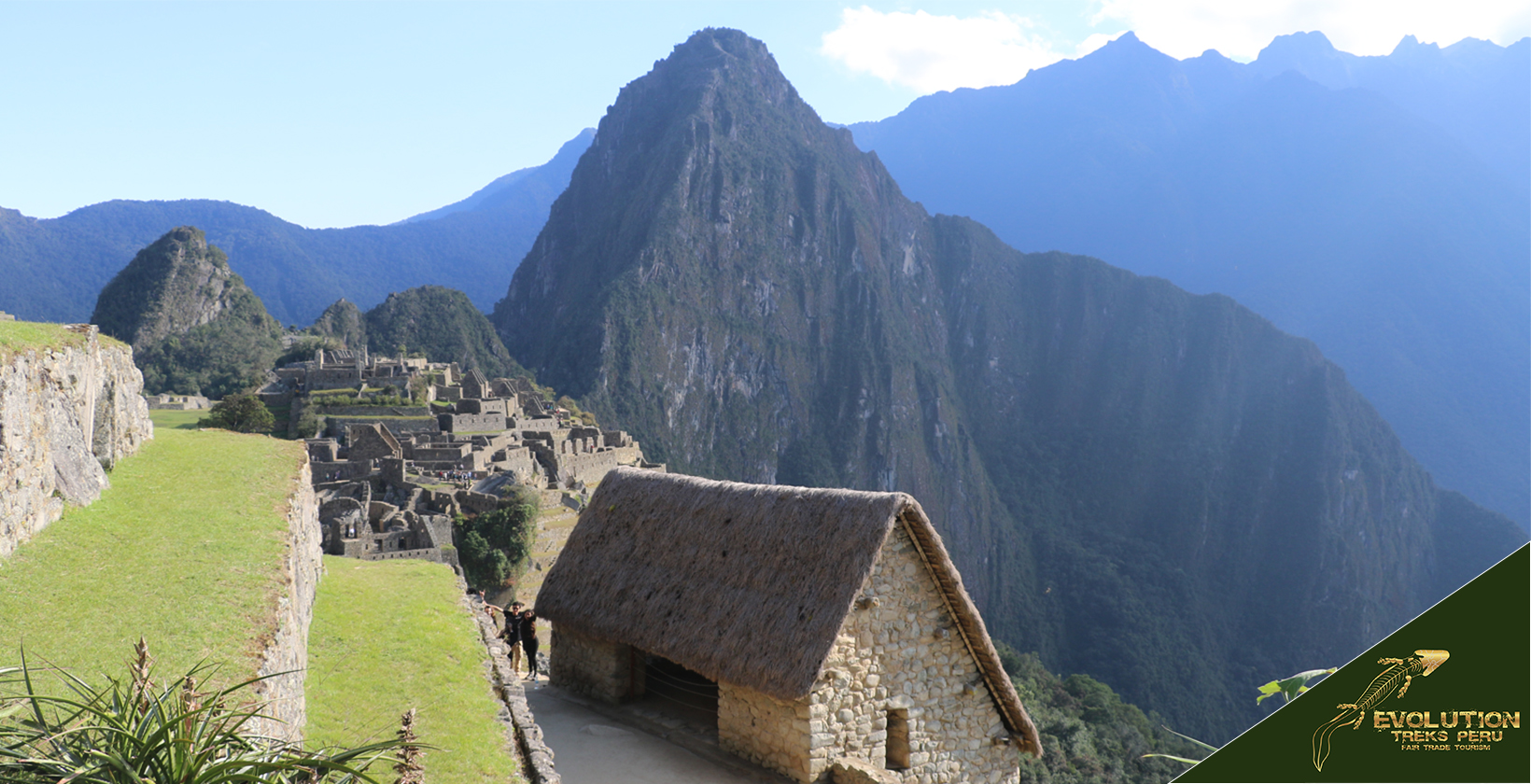
What are the closest destinations to Huayna Picchu?
The closest destinations to Huayna Picchu are the following:
- Santa Teresa. Santa Teresa is located at the other end of the Salkantay trek, opposite to Mollepata. It is officially the end location of the Salkantay trek and the site of the Cocalmayo hot springs.
- Aguas Calientes or Machu Picchu pueblo. It is the name of the most important city close to Machu Picchu. Aguas Calientes is a tourist city that hosts many hotels, restaurants, and other tourist services. The train and bus stations are located here, and the thermal baths are perfect places to recuperate and unwind after the arduous trek through the Salkantay mountain.
- Ollantaytambo. Ollantaytambo is located at the Sacred Valley of the Incas and is the location of the train station and one of the most beautiful archeological parks of Peru.
- Machu Picchu – From Machu Picchu, you can reach the top of Huayna Picchu in one hour.
- Huchuy Picchu is the new attraction in Machu Picchu, a small mountain located next to Huayna Picchu. You must take only about 1-hour hiking to get there. At the top, there are beautiful scenic views of the archaeological site.
How to get from Cusco to Huayna Picchu?
Listed below is the guide for getting from Cusco to Machu Picchu.
First, the first thing to do is arrive in Peru; most foreign planes that land in Peru land in Lima. From there, the next step is to make your way to Cuzco. Tourists can take a plane from Lima to Cusco, which takes approximately fifty-five minutes. Alternatively, they can go by bus, which, due to the mountainous landscape of Peru, would take about twenty hours of travel time.
Second. After arriving in Cusco, tourists can take a train, set off on foot, or use a car and hiking to get there. Most tourists look forward to the relaxing two to the three-hour train ride from Poroy, close to Cusco, or Ollantaytambo in the Sacred Valley to Machu Picchu Station. In contrast, some others will choose the much more prolonged and cheaper “Amazonic Access,” which will couple a tedious five-hour car ride from Cusco to Hidroelectrica with a three-hour walk over a path next to the train tracks until they reach Aguas Calientes town. A small minority of people will select to hike the Inca Trail, which after one or four days of hiking, terminates at the Sun Gate of Machu Picchu rather than passing through Aguas Calientes on the way to the ancient incan citadel.
Third. Tourists will travel to Machu Picchu by taking a brief bus ride from Aguas Calientes, where the nearest train station to Machu Picchu is located. The ride to Machu Picchu will take approximately twenty-five minutes.
Fourth. The entrance to Huayna Picchu mountain is located inside the Inca city of Machu Picchu. However, you will only be able to enter if you have purchased the Machu Picchu + Huayna Picchu ticket.
After entering the Inca city of Machu Picchu, the visitor must go to the area of the Sacred Rock. The entrance gate to Waynapicchu mountain is right in front of this construction.
What to know before going to Huayna Picchu?
Listed below are the instructions before going to Huayna Picchu.
- Buy Machu Picchu and Huayna Picchu tickets – An advance booking of tickets going to Machu Picchu and Huayna Picchu is needed. The advance booking is to ensure a maximum capacity of 400 people a day. Buying the ticket in advance saves time and effort for tourists going to the mountain.
- Visiting the Inca architectural site – One can access Machu Picchu mountain before heading to Huayna Picchu. Huayna Picchu’s entrance is in the northern part of Machu Picchu.
- Practice adventure sports – One should practice adventure sports before going to Huayna Picchu. The mountain has a steep, narrow, and sometimes slippery trail that might scare a less frequent hiker. Practice in an adventure sport is needed for one to be prepared for the majestic trail of the mountain.
- Inca Rituals – The ritual should be followed before going to the mountain of Huayna Picchu. It is to pay respect and homage to the Inca civilization and its ancestors. Rituals are to be followed and observed for one’s understanding of their customs and culture.
When is Huayna Picchu open?
Huayna Picchu is open every day of the year except in February, when the trail is closed due to heavy rainfall. The opening hours are from 7 am to 1 pm. Also, Machu Picchu does not close any day of the year except in cases of emergency, such as natural disasters.
How is the Huayna Picchu itinerary?
Below is the best itinerary for climbing Machu Picchu
First, catch the shuttle from Aguas Calientes to Machu Picchu at 6 am. You must arrive at the bus station at least 45 minutes before your bus departure.
Second, Once you check in with the park rangers, proceed on your guided tour of Machu Picchu from 7 to 9 am. Two hours are enough to go on the guided tour, which should finish at the ‘Sacred rock’, right next to the gate to enter Huayna Picchu Mountain.
Third, Continue to hike to the summit of Huayna Picchu mountain. At the fork, 20 minutes into the path, take the path on the right if your first destination is the mountain summit or the one on the left if you plan on going to the Great cave or ‘Temple of the moon’. Remember to check out at the end of your hike so park rangers know you exited safe and sound.
Fourth, continue on the last part of the Machu Picchu tour by visiting the industrial area and the ‘Temple of the condor’.
Important: The only way to enter Huayna Picchu is by booking the Machu Picchu + Huayna Picchu Ticket in advance. This ticket also allows the tour of the Inca Citadel. The entrance is divided into three different schedules.
Group 1: 07:00 a.m. to 08:00 am. (Entrance and departure to Machu Picchu are from 06:00 am to 01:00 pm)
Group 2: 07:00 a.m. to 08:00 am. (Entrance and departure to Machu Picchu are from 07:00 am to 02:00 pm)
Group 3: 10:30 a.m. to 11:30 am. (Entrance and departure to Machu Picchu are from 08:00 am to 02:00 pm)
How much does it cost to visit Huayna Picchu?
200 soles / 52 USD is the cost of an adult ticket, while the ticket for students and minors costs 118 soles. Also, the price for Peruvians and people from the Andean community of nations (Colombia, Bolivia, Ecuador) is 112 soles / 32 USD for adults and 80 soles / 22 USD for students and minors.
In 2023, tickets for Huayna Picchu must be booked at least four months in advance; especially if you are traveling in the dry season (April to August)
What is the best vehicle for visiting Huayna Picchu?
You must walk up its stone stairs to get to the top of Huayan Picchu. Before that, you will need to make your way to Machu Picchu.
The train is the most comfortable and convenient way to travel to Machu Picchu. Two train companies offer services to reach Machu Picchu: PeruRail and IncaRail. Tourists can take any one of these trains to get there. When traveling to and from Machu Picchu, passengers who travel by train with PeruRail have access to luxury trains that travel through the breathtaking Sacred Valley. Three distinct varieties of trains can be used to travel to a destination; the Expedition train is the most cost-effective option.
The Vistadome train is slightly more comfortable than the Expedition as it provides a better outlook with windows on the corners and ceiling. The Belmont Hiram Bingham train is the most luxurious of all trains traveling to Machu Picchu. A restaurant, an observatory, a bar, and several more amenities are available to guests. However, despite its expensive cost, the Belmont Hiram Bingham is a once-in-a-lifetime experience. On the other hand, tourists can take Inca Rail to arrive at the archaeological site of Machu Picchu. The Voyager, the 360, the first class, and the private trains are the different classes of trains that fall under the Inca Rail umbrella.
The Voyager is the most affordable train option that can accommodate 42 passengers at a time. The seats have tables and comfortable chairs, and guests can take in breathtaking scenery through the glass windows. On the other hand, the 360 is larger and wider, with additional windows providing a view in every direction. In addition to that, there is a bar located on the outdoor viewing carriage.
Pricier options like first class and private travel are the best, but they come at a higher price. Both the first class and the private cabins provide outstanding service. Tourists can dine and drink at a table in a comfortable setting while taking in the breathtaking scenery that is passing by.
.
How many hours should a person spend at Huayna Picchu?
Four hours is the maximum time a person can spend at Huayna Picchu Mountain. Also, Visitors should allow an extra two hours to tour Machu Picchu before climbing the magnificent Mountain. The Maximum time allowed to spend in Machu Picchu is six hours.
Is it possible to stay at Huayna Picchu?
No, it is not possible to stay at Huayna Picchu, nor is it a place where overnight visits are permitted. The closest to Machu Picchu that people can stay is the luxurious five-star Bemond Machu Picchu Sanctuary hotel.
However, even the Sanctuary hotel guests can only enter Machu Picchu during the assigned opening hours.
Camping is not allowed within Huayna Picchu either; the nearest campground is located 20 minutes by bus at the bottom of the Mountain, next to the river at the Campamento Municipal. Also, most hotels are located in Machu Picchu town or Aguas Calientes, located 25 minutes from Machu Picchu.
What was the purpose of Huayna Picchu for the civilization that built it?
Scholars believe that the Inca civilization was responsible for the construction of Machu Picchu. One of the most recent leading theories about Machu Picchu suggests that the citadel was built at the end of the XIV century by Pachacuti Inca Yupanqui, the most influential man in the history of the Andean people.
Pachacuti, or the Earth’s transformer as his name is translated, was the one who commanded his people to build Machu Picchu and other massive Incan settlements in South America. Scholars believe that approximately 5,000 people working at all times and for about forty years were responsible for the construction of Machu Picchu.
The Inca civilization expanded throughout the Andean mountains of South America until their collapse in the early XXVI century. It covered Chile, Peru, Bolivia, Argentina, Colombia, and Ecuador territories. Essentially, it was a pan-Andean empire that absorbed hundreds of ethnic groups, and small and big kingdoms, throughout a vast region comprehending an enormous amount of ecosystems.
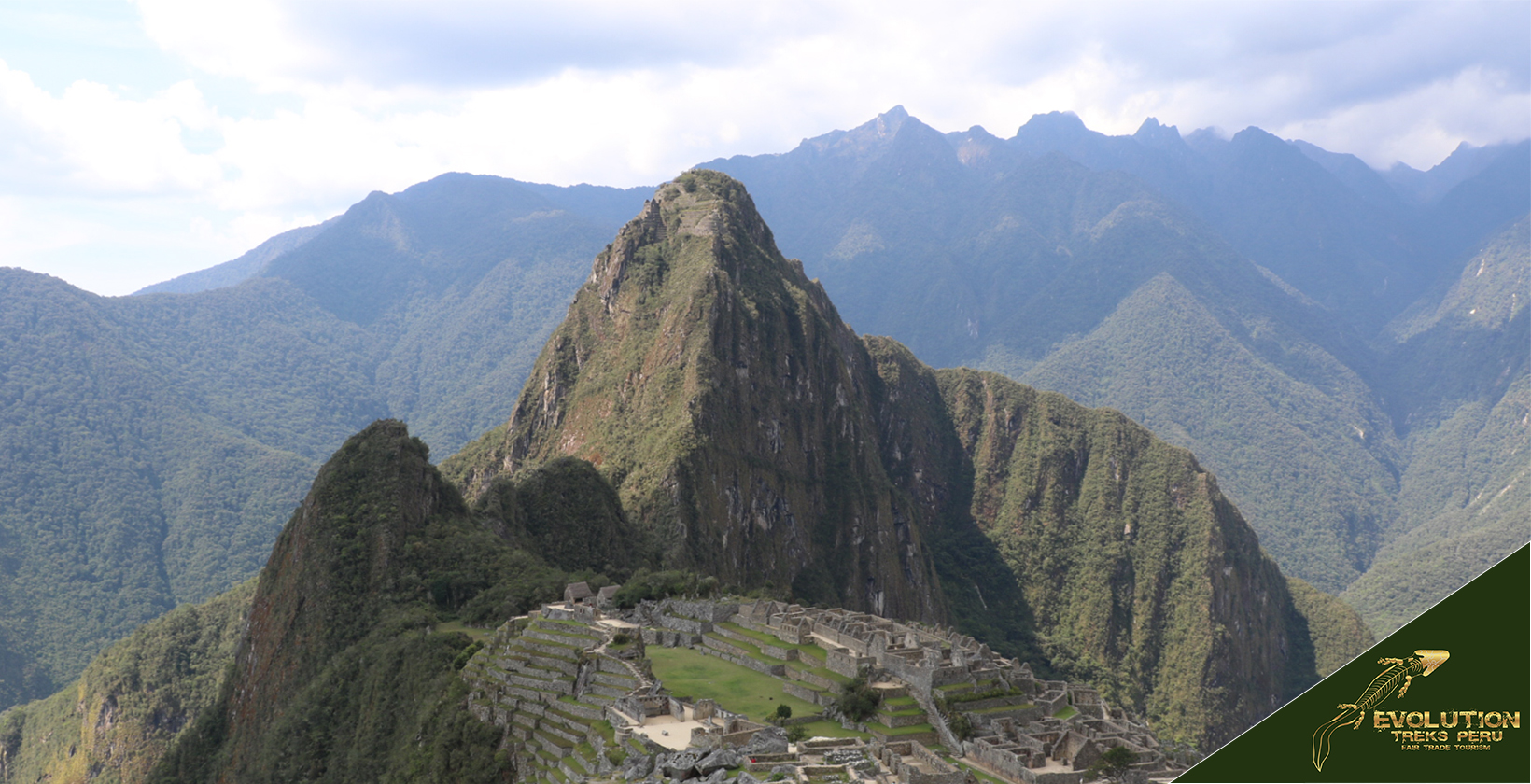
The Huayna Picchu mountain, Wayna Pikchu in Quechua, (with an altitude of 2667 meters above sea level) is part of the eastern foothills of the Salcantay massif in Cuzco, Peru. It is part of a sizeable orographic formation known as the Vilcabamba Batolith in the Central Cordillera of the Peruvian Andes. Huayna Picchu flanks Machu Picchu on the northern side, and two mountain ranges cross it: the Urubamba and Vilcanota ranges. Also, on the outskirts of the Machu Picchu sanctuary is located in the massive Salkantay. This Mountain is the second-tallest Mountain in the Cusco region at 21000ft or 6,271 meters above mean sea level. Moreover, the water from the famous Vilcanota River flows through the deep valleys of Machu Picchu headed to the Amazon basin.
Huayna Picchu and its Inca trails have a wide presence of trees and flora. It is said that there are 50 species of trees per hectare. There are also multiple types of polylepis, ferns, shrubs, orchids, and vascular flora. The Huayna Picchu mountains highlight the presence of cedar, laurel, muña, falcatas, begonias, and puyas. The maximum temperature is 19 °C to 21 °C, and the minimum is eight °C to 11 °C. At night, at the heights of the Mountain, the temperature can drop to 0 °C.
What is the geological profile of Huayna Picchu?
Huayna Picchu is part of the eastern foothills of the Salcantay massif in Cuzco, Peru. It is part of a sizeable orographic formation known as the Vilcabamba Batolith in the Central Cordillera of the Peruvian Andes. It is the Mountain located in front of Machu Picchu. Its Quechua name translates as “young mountain” Huayna Picchu was a guard post, communication station, and shrine.
It has a height of 2,667 m., and the summit has an area of approximately 2,000 square meters. From there, you can see the main square of Machu Picchu about 400 meters down, and the overall picture is impressive, the dizzying Urubamba canyon of infinite shades of green and white snow-capped peaks in the background. The Urubamba River surrounds its circular base on the north side of the Sacred City of the Incas.
What are the archeological findings in Huayna Picchu?
The Inca town was known to be called Huayna Picchu. A landowner’s son told the scientist Bingham that they called the place Picchu or Huayna Picchu. Huayna Picchu is where the Inca inhabitants flourished. Some relics found were ceramics, stone tools, human remains, and animal bones, adding up to 5,000 artifacts.
The known Temple of the Moon was discovered on the mountain of Huayna Picchu. It is located in the hidden part of the mountain, near the stairs of death. The temple is known to have stone carvings that show Inca art and architectural work.
It is said to have been established as a ceremonial site for the people of the Inca. It has semi-circular carvings that look like a moon, which is where its name originated. The archaeologists often call it “The Great Cavern.” The shallow cave has a stone carved as a throne.
What is the nearest city to Huayna Picchu?
Aguas Calientes, or Machu Picchu pueblo, is the closest city to Huayna Picchu mountain. It is located 8 km from the Machu Picchu entrance and can be covered in 25 minutes by shuttle bus.
What are the books about Huayna Picchu?
Listed below are the books about Huayna Picchu.
Machu Picchu Guidebook: A Self-Guided Tour. Ruth M. Wright and Alfredo Valencia Zegarra.2004.
- Machu Picchu: Peru’s most famous archaeological monument. Luis E . Valcárcel. 1964.
- Machu Picchu, The Lost City of the Incas. Hiram Bingham. 1948.
- Guide to Machu Picchu. Antonio Zapata Velasco. 1999.
- Machu Picchu: the Sacred Center. Johan Reinhard. 2002.
- Turn Right at Machu Picchu by Mark Adams. First Published in 2011, USA
- The Heights of Machu Picchu by Pablo Neruda. First Published 1944, Chile.
- Machu Picchu: Unveiling the Mystery of the Incas by Richard L. Burger and Lucy C. Salaza. 2004, USA
Who are the scientists who worked on Huayna Picchu?
- Hiram Bingham introduced the world to the great Inca citadel of Machu Picchu. In 1912, Bingham organized another expedition to explore Machu Picchu, sponsored by Yale University and the National Geographic Society, which granted him the first aid that this institution had given to archaeological research.
- Luis Valcárcel and Manuel Chávez Ballón were also present doing very important work in Macchu Pichu.
- Engineers Ken and Ruth Wright studied the main spring and hydraulic system.
- In 1977, Graziano Gasparini and Luise Margolies published the first major study of Inca architecture.
- Johan Reinhard argued in his book The Sacred Center that the impressive location of the llaqta of Machu Picchu was related to the nearby mountains, apus, which were literally the pinnacle of the Inca cult of the natural world, as well as being the source of water and associated with astronomical phenomena.
- In 1986, John Rowe analyzed a 1568 document in which informants, including the caciques of Tambo and Picchu, indicate that Pachacútec conquered the area and that most of the land in the lower part of the valley belonged to him. Rowe proposed that the Machu Picchu llaqta was a property based on this and other considerations. This was a turning point in the explanation of Macchu Picchu.
- Craig Morris and Adriana von Hagen consider Machu Picchu as the culmination of a series of monuments along the Yucay valley and the Inca Trail, so it could have been a religious destination or, due to its modest defenses, founded as a frontier post, which evolved into the main of Pachacútec’s royal estates.
- Brian Bauer, Terence D’Altroy, Susan Niles, Jean-Pierre Protzen, and John Hemming agree in considering the llaqta of Machu Picchu as a royal palace of Pachacutec, one of the four he built in the Yucay valley north of Cusco.
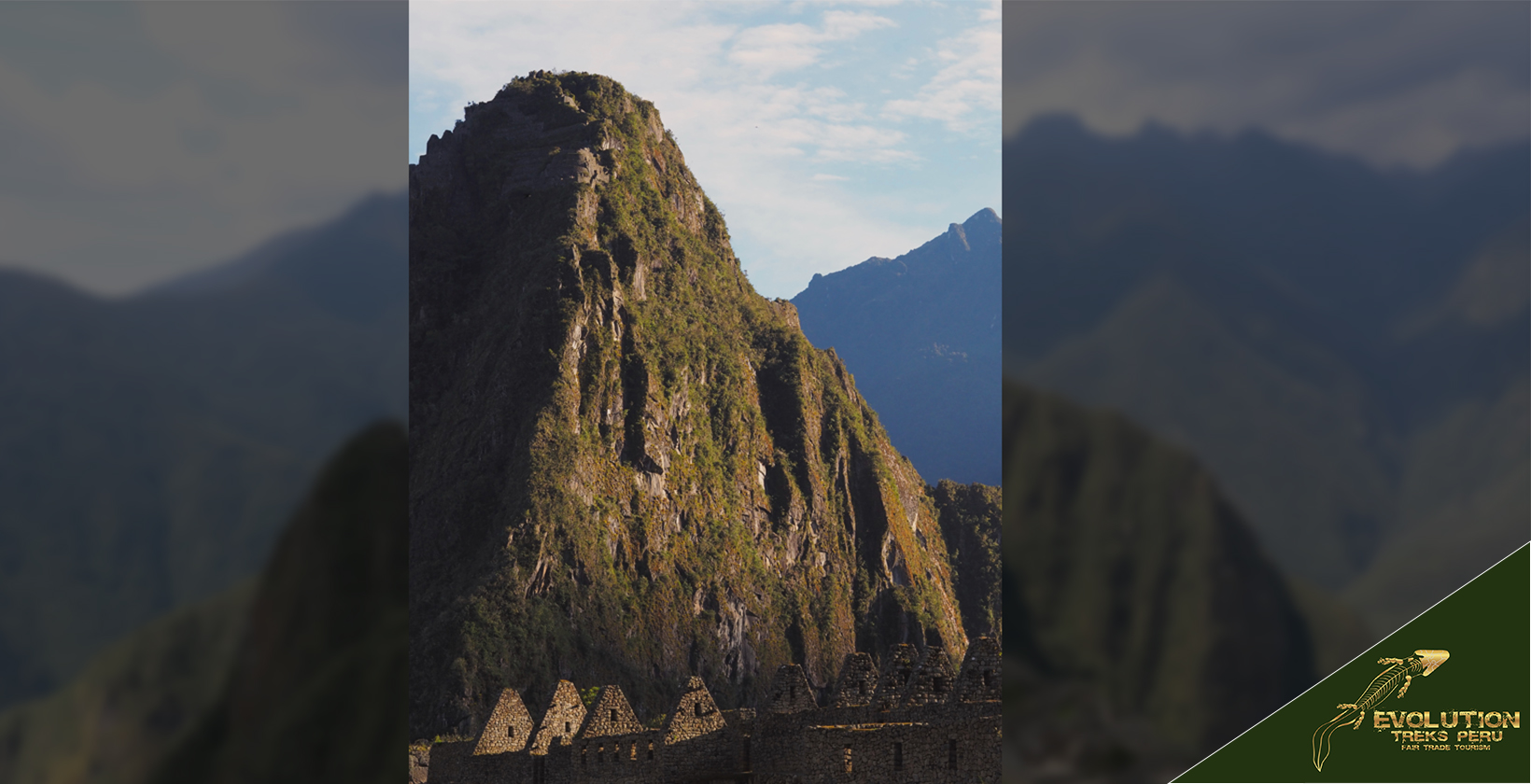
What does Huayna Picchu Mean?
Young Mountain is the meaning in the native aboriginal Quechua language that is spoken in the Andes of Peru, Bolivia, and Ecuador. It is believed that the names come from contrasting two different mountains, one taller than the other one in which. Machu Pichu, the old Mountain (a 3,000-meter high), sits right next to its counterpart Huayna Picchu (2677 meters high), which stands at a lower altitude on the opposite side of Machu Picchu mountain.
Which district is Huayna Picchu in?
Huayna Picchu is located in the district of Machu Picchu, province of Urubamba, in the Cusco region at 2,677 m.a.s.l.
Is Urubamba close to Huayna Picchu?
Yes, the Urubamba River is close to Huayna Picchu, which runs at 1550 feet / 472 meters deep, at the foot of Machu Picchu, the Inca citadel. The altitude of the Urubamba River at Machu Picchu is 6690 FASL / 2040 MASL. In addition, the Urubamba River passes through other significant towns in the Sacred Valley, such as Pisaq, Urubamba, and Ollantaytambo.
Does the Urubamba river affect the history of Huayna Picchu?
In a highly symbolic and spiritual way, The Urubamba always affected the lives and history of the people at Huayna Picchu. During the time of the Inca Empire, the Urubamba River valley was considered sacred because of its proximity to Machu Picchu. In ancient times, the spiritual and agricultural center of the Inca Empire was located along the Urubamba River. Corn, coca, potatoes, and other crops were grown in the fields and along the mountain slopes, and the Incas’ astrological traditions reflected the river’s constant flow. The original name of the Urubamba River in the Quechua language of the Incas is Willka Mayu. In the Andean cosmovision, the Milky Way and the Urubamba River shared the same name and were thought to reflect each other as part of their dualistic beliefs.
How did people in Huayna Picchu Live in the Past?
Scholars believe that Huayna Picchu served as a surveillance center for the citadel of Machu Picchu. With the construction of this place, the Incas were alert to any eventuality or adverse attack they might receive. Also, in Huayna Picchu, religious ceremonies were held. This is demonstrated by some of the temples, such as the Great Cavern (also known as the Temple of the Moon). From the evidence found, it is believed that these temples were still under construction when the Inca city was abandoned in 1535.
At the top of this Mountain, you can see many constructions near the abyss that were used for the cultivation of ornamental species and to serve as retaining walls. From this point, the entire citadel of Machu Picchu can be seen.
How was agriculture in Huayna Picchu?
Large agricultural practices were not performed at Huayna Picchu due to its steepness and rugged location. Even though numerous terraces are on the edge of the abyss, they were mainly dedicated to supporting the area’s buildings. It is likely that growing ornamental, medicinal plants and other species considered sacred was incipiently practiced in this Mountain.
How was mining in Huayna Picchu?
Just like farming, mining in the Huayna Picchu mountain was not a common practice, and it was subordinated to what happened in Machu Picchu. The Incas possessed significant amounts of gold and silver, which lacked economic power but represented nobility status and importance.
The gold and silver used by the Inca came exclusively from surface sources, either in the form of gemstones or as a result of panning river beds. There were no mines among their possessions and no mining during that time. On the other hand, when they were mining stones to utilize in the construction of Machu Picchu, they employed tools made of bronze to cut the rocks and more rigid stones from a quarry nearby.
Metallurgy has been especially important at Machu Picchu and, therefore, at Huayna Picchu. The site is well situated for this activity due to abundant fuel, and its exposed configuration would have favored the use of draft furnaces and other wind-harnessing techniques.
Some of the best evidence of metallurgical activities at Machu Picchu comes from laboratory analysis of the collections recovered by the 1912 Yale Peruvian Expedition.
Of the approximately 170 metal artifacts recovered during excavations at Machu Picchu, 15 have been identified as pure metal stock, work-in-progress, and scrap materials from metallurgical work.
Most were related to manufacturing tin bronze objects, a copper alloy linked to the Inca State.
Only in the expansion of Tahuantinsuyo southward during the 15th century A.D. tin become available to Peruvian goldsmiths, and tin bronze finally appeared in the Cuzco region.
Due to Inca expansion, this metal was disseminated throughout the Central Andes and replaced or complemented the arsenical bronze alloys that had been produced in earlier periods.
It is likely that the Inca state-controlled tin production and, by extension, dominated the production of tin bronze artifacts. Therefore, the objects manufactured with this type of alloy were not only hard and durable products, but their composition also symbolized the Inca rulers’ power.
This link between tin bronze objects and the Inca state was also reflected in their distinctive characters, as they represented a limited variety of forms that have been found throughout the Tahuantinsuyo.
Other artifacts found at Machu Picchu during the 1912 work reveal that silver and copper alloys were also produced.
Heather Lechtman (1997) argued that Inca metallurgy consisted of three components: copper, silver, and gold. At least two of these metals were being manufactured at Machu Picchu: because of this, metallurgical work at the site was not limited to a basic level.
Their study has provided new evidence regarding the innovative character of Inca metallurgical technology.
Another type of innovation suggested by the technical studies refers to the use of metal to manufacture tools in Machu Picchu.
How was the economy of Huayna Picchu?
The Inca people who lived in Huayna Picchu were largely dependent on the economic activities carried on at Machu Picchu as both locations were intrinsically integrated.
The economy of Machu Picchu was based on the principles of the Incan economy, which was highly planned and centralized, and it was one of the most prosperous ever witnessed.
Its success can be attributed to the effective labor management and the administration of the resources gathered from every corner of their Empire as a tribute.
The Inca society was built on a foundation of collective work, which served as the engine that drove both economic output and the accumulation of social riches.
People in the “Ayllu,” which served as the center of industrial productivity, generated such a large amount of wealth through cooperative labor that the Spaniards were astounded by what they saw when they arrived.
Every person was obligated to contribute with their share of labor required by the Inca estate. The Inca ruling class gave harsh collective punishments, including death sentences to people for refusing to work or being lazy about contributing.
Labor was divided up according to the region; agriculture would be focused on the regions that were the most productive; ceramic manufacture, building roads, textile, and other talents would also be focused on those regions, according to ‘Ayllu”.
After meeting the community’s requirements, the government gathered any extra resources and redistributed them to areas where they were required. People were given free housing, clothing, food, medical care, and educational opportunities in return for their labor.
At Machu Picchu and all over the Inca empire, the population did not utilize money because they did not require it in their society.
Due to the careful general planning that went into their economy, every citizen’s fundamental needs were satisfied. People used the barter system to conduct economic transactions, exchanging with one another for the goods and services they required.
How was daily life in Huayna Picchu?
Traditional characterizations of Machu Picchu have focused on the Inca elite for whom the site was built and maintained. Spanish chronicles and archaeological evidence are clear that the Inca rulers looked to their small ethnic group for imperial leadership. Accordingly, Machu Picchu’s distinctive architecture embodies the culture and social values of the dominant Inca ethnic group of the Cuzco Valley.
However, historical documents clarify that the Yanaconas (servants) of the royal panacas came from a wide range of ethnic groups incorporated into Tahuantinsuyo through conquest or peaceful means.
Because the vast majority of the inhabitants were probably yanaconas serving as support staff and artisans, one would expect the site population to be a multi-ethnic mix reflecting the complex composition of the Empire, particularly those areas included through Pachacútec’s military and political activities.
Based on the analysis of the grave goods, Lucy Salazar has argued that most of the people buried at the site came from areas outside of Cuzco.
One of the most common ways to express identity in the pre-Hispanic Andes was through cranial deformation. This was achieved by tying infants in cradles or other devices while the skull was still relatively malleable.
Other analyses focused on the statistics of facial portions of the skulls and revealed that approximately half of those from Machu Picchu could be classified as costeño. Many of these are similar to those from the Jequetepeque Valley samples on the northern coast of Peru, but others are more similar to those from the country’s central coast.
Based on these two independent lines of evidence, it was concluded that the population buried at Machu Picchu was ethnically heterogeneous.
The population of Machu Picchu was generally in good health. However, dental caries was a common problem, suggesting consuming foods high in carbohydrates, such as corn.
Likewise, Machu Picchu has no more severe pathologies, such as skull fractures produced by armed combat.
This absence contrasts sharply with findings at other late pre-Hispanic sites in Cuzco. Similarly, osteological evidence of advanced arthritis and other markers of occupational stress was surprisingly limited. This suggests that the workload of the Yanaconas at Machu Picchu was reasonable and less than at different types of Inca sites.
It is reasonable to assume that the good health of the Yanaconas of Machu Picchu was based on an adequate diet: maize was the main food for the servants, and the consistency of various analyses leaves little doubt not only that the servants and other personnel had access to maize, but that it constituted the basis of their diet.
When corn is combined with beans, lupine, and other crops, it is an extremely rich source of protein and other nutrients. The excellent health of the Yanaconas of Machu Picchu, both men, and women, was, to some extent, the result of this imperial diet. The equivalence of foods in their diet suggests that the Yanaconas drank chicha and participated in activities associated with its consumption.
At Machu Picchu, meat would have been another source of protein and nutrients for the Inca elite and their staff; the Incas consumed the meat and the abundant fragments of animal bones at Inca and pre-Inca sites dispel any doubt about their presence in the diet.
What were the religious beliefs in Huayna Picchu?
At the summit of Huayna Picchu mountain, a few buildings were clearly dedicated to astronomical and religious practices. Also, in the Temple of the Moon area, there is a mysterious building deemed the Temple of the Monkey, which consists of two huge boulders that have been nailed together in a rock cavern, with an altar and niches carved inside.
Archeologists believe it was used for astronomy or as a place to worship jungle animals, while others think it might have been used for sacrifices due to its beauty and craftsmanship. On both sides are carvings of different animals, such as snakes and condors, which were thought to be holy symbols; inside, there is also an area shaped like a table below a light-letting hole.
How is the past of Huayna Picchu presented to the visitors?
Huayna Picchu is presented to visitors as the guardian of Machu Picchu, a powerful, tall and impressive mountain protecting the citadel. As per the climb to Huayna Picchu. The travel website World Travel Guy refers in the following terms on his visit to Huanya Picchu:
Is Wayna Picchu Worth It?
Yes, the Wayna Picchu hike is so worthwhile!
It’s a fantastic combination of scenery, history, thrills, and challenge. We loved this hike, and I hope I can do it again someday, and it’s like something out of Indiana Jones.
How is the preservation of Huayna Picchu?
Huayna Picchu is preserved and administered by Peru’s Ministry of Culture. Huayna Picchu officials work on strengthening the ground life at Huayna Picchu. This preservation strategy avoids the tendency for landslides and slides. The use of sneakers and soft-soled boots aids in the preservation of the area.
The rules implemented by the Peruvian government are also for the preservation of the fauna and flora of the area. No damage should be caused to archeological sites. It is also forbidden to pollute the forests, lakes and rivers surrounding the Mountain.
The local government applies proper waste management to avoid contaminants in the surrounding area.
The authorities are doing everything possible to manage the large influx of tourists by means of visitation schedules, defined circuits, explanation areas, new accesses, and exits, as well as planning a future visitors’ center at the base of the Mountain.
For conservation reasons, some sectors or enclosures have had to be closed to the public, but this is done in the most discreet way possible with only a thin rope a few centimeters above the ground, without doors, bars, or signage.
For example, this year, 2023, visits to the Temple of the Moon have been suspended until further notice. As a result of all of the above, hundreds of thousands of people can experience the unsurpassable thrill of seeing the world-famous Machu Picchu llaqta with all possible guarantees and security.
Is there a modern town in Huayna Picchu?
No, there is not a modern town called Huayna Picchu. The closest modern town to Huayna Picchu is Aguas Calientes. It is known as the gateway to Machu Picchu, Huayna Picchu, and Huchuy Picchu. Tourists can stay in Machu Picchu hotels.
How is the Map of Huayna Picchu Layout?
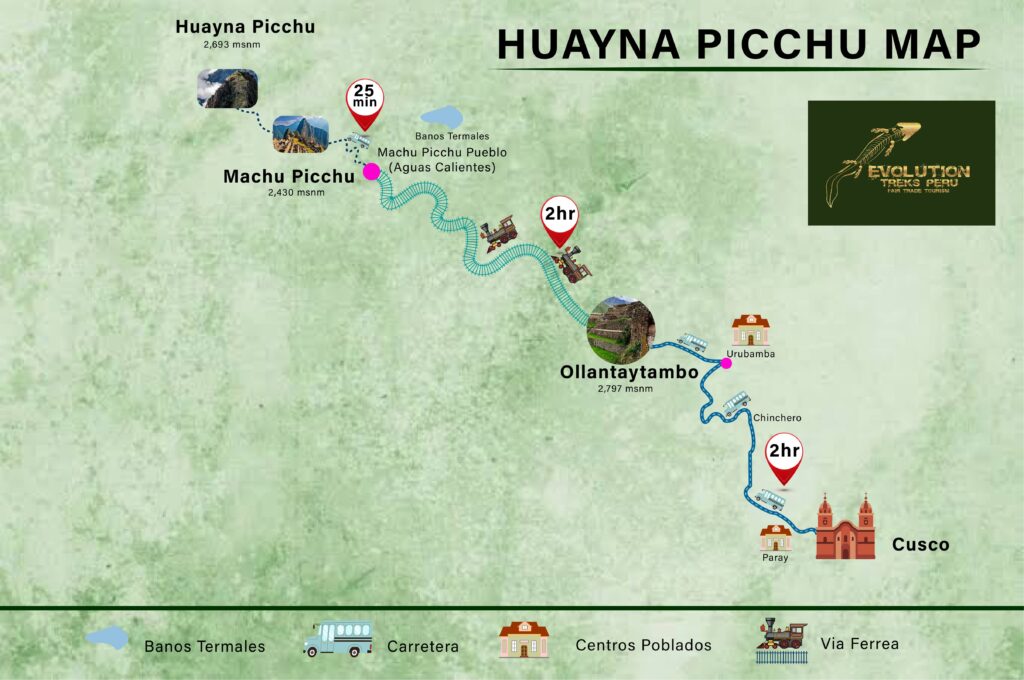
What was transportation to Huayna Picchu during Incan times?
The ascent to Huayna Picchu had to be made on foot. Domesticated camelids were essential for transportation and wool production throughout the Inca Empire, and their presence was likely common near Machu Picchu. Both llamas and alpacas were consumed in Inca times, although their role as a food source was traditionally considered secondary to their other economic functions.
Does Huayna Picchu have a No-fly Zone?
Yes, a no-fly zone exists in both Huayna Picchu and Machu Picchu. In Peru, flying drones is prohibited in restricted areas, such as the Government Palace, military areas, airports, archeological sites (Machu Picchu and Huayna Picchu are included), and in protected natural areas unless authorized by the corresponding entities.
Is Huayna Picchu in the UNESCO World Heritage Sites?
Yes, as part of Machu Picchu, Huayna Picchu is a UNESCO World Heritage Site. Huayna Picchu was considered a World Heritage Site in the year 1983 since it was the home of the Incas. The Inca civilization contributed to the history of Peru and its neighboring countries in South America. The civilization of the Incas created majestic architectural sites. The architectural sites built by the Incas were built with the use of indigenous materials and techniques. The Incas left some of their ruins and architecture that are now part of Peru’s history and culture.
What is the contribution of Huayna Picchu to tourism in Peru?
According to projections by the Peruvian Ministry of Culture, Machu Picchu will receive approximately 1.1 million domestic and foreign visitors in 2022.
Peruvian authorities have imposed a 4044 maximum number of people on entering Machu Picchu daily, which will remain valid until June 30, 2023, and, likewise, only 400 visitors will be allowed in Huayna Picchu.
Is Huayna Picchu under danger?
No, Huayna Picchu is not endagered thanks to the current administration, which has emphasized permanent research and conservation of the monument.
The visitor experience at Machu Picchu has always been better, in several respects, than at almost all of the world’s most famous sites. One of the reasons is that there is absolutely no commerce anywhere in the monument: no vendors or stalls selling tourist souvenirs, and all of this is done in Aguas Calientes. Another reason is that the park rangers from the Ministry of Culture are locals who guard the monument and guide visitors properly. The days when lucky visitors could tour the monument at will are gone forever.
Is Huayna Picchu floating in the past?
To go to Huayna Picchu and Machu Picchu is to travel and float to a millenary past that makes all Peruvians proud.
For the great Chilean poet Pablo Neruda, walking amidst the “stone permanence” of Macchu Picchu was a symbolic resurrection that made him “totally committed to the indigenous American peoples, their indigenous roots, their past and their future.”
Archaeologist Andrew Reinhard marveled at “the dream of seeing an ancient city materialize from the clouds, one of the few places where reality surpasses imagination.”
The Incas pierced the skies and times with a mighty stone city.
How many artifacts were recovered from Huayna Picchu?
In 2012, Yale University completed the return of 46,000 artifacts from the Huayna Picchu and Machu Picchu mountains taken to the United States during Hiram Bingham’s expeditions to Peru. These included various ceramics, aríbalos, silver statues, gold pieces, and more than a hundred human remains.
How does the University of Yale return the artifacts of Huayna Picchu?
In 2012, Yale University returned the last batch of archaeological artifacts from Machu Picchu that it had agreed to deliver following an agreement signed in 2010 with the Peruvian government.
More than 35,000 ceramic and lithic fragments were privately transported to the city of Cusco in 127 boxes that joined two other batches sent by the U.S. university in March and December 2011.
The first shipment consisted of 366 pieces ready for exhibition, and the second consisted of another 218 that are already on display at the Machu Picchu museum of the Casa Concha, in the city of Cusco.
The agreement between the Peruvian government and the U.S. university was reached in 2010 amid a legal dispute and an international campaign initiated by the Peruvian authorities to fully return the pieces and fragments found by the American explorer Hiram Bingham in the Inca citadel.
What are some Sample Artifacts from Huayna Picchu?
Some Sample Artifacts from Huayna Picchu.
Mascaypacha – It is a cloth made by the Inca civilization. The textile is structured with red dye where each tassel represents its conquered people. It shows the Incas’ rulership, conquest, and blood through its textile. The colors of the textiles are extracted from plants, minerals, and insects during their era.
Tumi – It is an object dedicated to being a ceremonial knife for the Inca civilization. The knife is made with precious metals like gold, copper, and bronze. Precious metals were prominent during the life of the Incas. Most people are working in mining around the mountain of Huayna Picchu.
Punchao – It is a golden statue of Inti, the Inca god of the sun. It is presented as a small boy seated in the sacred complex of the Temple of the Moon. The Inca believed in many gods, one of which is the sun god, Inti. The Inca renounce their faith in the sacred temple called the Temple of the Moon located on the mountain of Huayna Picchu.
Urpu – It is a bulging vessel used for storing crops. The vessel has a long neck, a flared lip, a pointed vessel base, and two little handles on the lower part of the pot. The vessel’s point at its base is pressed into the ground to stabilize it to pour into the crops like maize.
What are the movies about Huayna Picchu?
The movies about Huayna Picchu.
Aguirre, the Wrath of God (1972): The 1972 movie Aguirre, the Wrath of God (1972) was filmed on the stone pathway of Huayna Picchu.
The Path (2016-2018): The movie series, The Path, was filmed climbing at the top of Huayna Picchu. The movie was about a fictional religion called Meyerism.
The Secret of the Incas (1954): The movie portrays an adventurer looking for hidden treasures in the mountains of Peru.
Who are the famous people visited Huayna Picchu?
Listed below are the famous people who visited Huayna Picchu.
Hiram Bingham III – The Man Who Introduced the Inca Civilization, which includes the Discovery of Machu Picchu and Huayna Picchu. Bingham braved the trails of two mountains to record and discover the wonders of architectural sites and monuments in the mountains.
Che Guevara – One of the men that hiked the Inca Trail. The man who exposed the discoveries of the mountain in the 2004 film, Motorcycle Diaries.
Pablo Neruda – Neruda is a poet and Nobel Prize winner who hiked the Inca trail. The man published numerous poems about his hiking experiences in the mountains.
Charlton Heston – Heston hiked the Inca trail and published a film called Secret of the Incas.
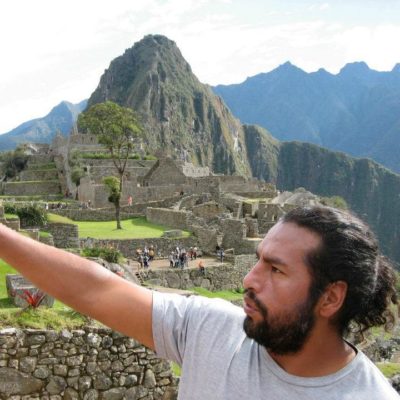
Miguel is a professional tour guide from Cusco, Peru, with almost 20 years of experience leading tours and a deep knowledge of Peru’s cultural and ecological diversity. He is also an advocate of ecotourism and cultural sensitivity and has lectured on these topics in the US and Europe. He co-founded Evolution Treks Peru, a worker-owned travel company based in Cusco.
